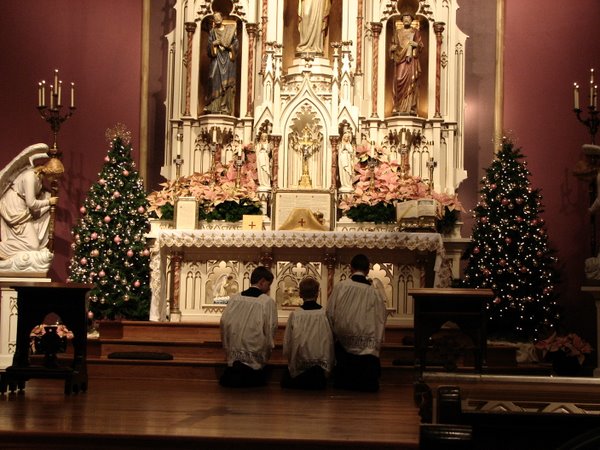The Feast of the Most Holy Name of Mary

September 12th marks the traditional Feast of the Most Holy Name of Mary. Here are few lovely quotes and observations about our Lady's Most Holy Name:
Pondering the Meaning of "Mary"
In Hebrew, the name Mary is Miryam. In Our Lady's time, Aramaic was the spoken language, and the form of the name then in use was Mariam. Derived from the root, merur, the name signifies "bitterness."
Miryam was the name of the sister of Moses; and the ancient rabbinical scholars perceiving in it a symbol of the slavery of the Israelites at the hands of the Egyptians, held that Miryam was given this name because she was born during the time of the oppression of her people. The Old Testament, chronicling as it does the "Time of Expectation" of the Redeemer, is filled with "types," or foreshadowings of people and events which would be made manifest during the "Time of Redemption," when. Christ walked the earth. Jesus Mary and Joseph, the Sacrament of Baptism, the Eucharist, the Sacrifice of Calvary, etc., are all foreshadowed in the Old Testament, but we view them there "through a glass darkly," so to speak, under the guidance of the Catholic Church, which alone possesses the authority to interpret the sacred texts.
Miryam, the sister of Moses is a "type" of the Blessed Virgin. Miryam was a prophetess who sang a canticle of thanksgiving after the safe crossing of the Red Sea and the destruction of Pharaoh's army; Mary prophesied in Her Magnificat that all generations would honor Her, and She sang of how God would topple the proud and raise the lowly. Miryam supported her brother, Moses, the liberator of his people; as the Co-Redemptrix who united Her sufferings to those of the One Mediator on Calvary, Mary labored alongside the Redeemer, the true Liberator of His people. Just as Jesus was the "antitype" [i.e., fulfillment] of Moses, so was Our Lady the "antitype" of Miryam, the fullest realization of the courageous woman standing beside, and laboring with, the one who comes to free captives.
Throughout the centuries, Saints and scholars have put forth different interpretations for the name "Mary." A mixture of etymology and devotion has combined to produce an interesting array of meanings:
"Mary means enlightener, because She brought forth the Light of the world. In the Syriac tongue, Mary signifies Lady." [St. Isidore of Seville +636]
"Let me say something concerning this name also, which is interpreted to mean Star of the sea, and admirably suits the Virgin Mother." [St. Bernard +1153]
"Mary means Star of the sea, for as mariners are guided to port by the ocean star, so Christians attain to glory through Mary's maternal intercession." [St. Thomas Aquinas +1274]
"This most holy, sweet and worthy name was 'eminently fitted to so holy, sweet and worthy a virgin. For Mary means a bitter sea, star of the sea, the illuminated or illuminatrix. Mary is interpreted Lady. Mary is a bitter sea to the demons; to men She is the Star of the sea; to the Angels She is illuminatrix, and to all creatures She is Lady ." [St. Bonaventure +1274]
"God the Father gathered all the waters together and called them the seas or maria [Latin, seas]. He gathered all His grace together and called it Mary or Maria . . .This immense treasury is none other than Mary whom the Saints call the 'treasury of the Lord.' From Her fullness all men are made
rich;" [St. Louis de Montfort +1716]
The hallowed title, "Star of the Sea," dates back to St. Jerome [+420]. It has been said that the great Doctor had originally used the phrase Stilla Maris to describe Mary as a "drop of the sea," the sea being God. A copyist's error, then, could have resulted in stilla [drop] being written down as stella [star]. Of course, the hallowed title, "Star of the Sea," suits Our Lady perfectly:
" 'And the Virgin's name was Mary.' Let us say a few things about this name, which can be interpreted to mean Star of the sea, an apt designation for the Virgin Mother. She is most beautifully likened to a star, for a star pours forth its light without losing anything of its nature. She gave us Her Son without losing anything of Her virginity. The glowing rays of a star take nothing away from its beauty. N either has the Son taken anything away from His Mother's integrity.
"She is that noble star of Jacob, illuminating the whole world, penetrating from the highest heavens to the deepest depths of Hell. The warmth of Her brilliance shines in the minds of men, encouraging virtue, extinguishing vice. She is that glorious star lighting the way across this vast ocean of life, glowing with merits, guiding by example.
"When you find yourself tossed by the raging storms on this great sea of life, far from land, keep your eyes fixed on this Star to avoid disaster. When the winds of temptation or the rocks of tribulation threaten, look up to the Star, call upon Mary!" [St. Bernard, Second Homily on the Missus Est]
The interpretation "Lady" for Mary was also proposed by St. Jerome, based on the Aramaic word, mar, meaning "Lord". This would render the meaning "Lady" in the regal or noble sense [as in "Lord and Lady."] Catholic sensibility, however, recognizing in Mary the simple dignity of a Mother, as well as the grandeur of a Queen, did not hesitate to add an affectionate touch to this majestic title. Mary is not just "Lady;" She is "Madonna," Notre Dame-----i.e., She is Our Lady. This aspect of Mary -----"Lady" or "Mistress"-----is close to Our Lord's Heart. We read in the Scriptures how, for a time, the youthful Christ made Himself "subject" to Her and St. Joseph, an act of Divine condescension which caused St. Bernard to wonder:
"Which shall we admire first? The tremendous submission of the Son of God, or the tremendous God-given dignity of the Mother of God? Both are marvels: both amazing. When God obeys a woman, it is humility without precedent. When a woman commands her God, it is sublime beyond measure." [First Homily on the Missus Est]
It is not difficult to see why these various interpretations of the name "Mary" should have been proposed and cherished, for they encapsulate many of our Marian doctrines and beliefs. "Bitter sea [mara = bitter; yam = sea]," for instance, in addition to the interpretation given by St. Bonaventure, also calls to mind Our Lady's Seven Sorrows and the sword which "pierced" Her soul on Calvary, recalling the lamentation of the mother-in-law of Ruth, who had lost a husband and two sons: "Call me not Noemi, [that is, beautiful,] but call me Mara, [that is, bitter,] for the Almighty hath quite filled me with bitterness [Rt. 1: 20]." Maror are "bitter herbs," such as are found on the seder plate at Passover.
The "Illuminated" points us to St. John's apocalyptic image of the "Woman clothed with the Sun," a dual image encompassing both the Catholic Church and Mary, the Mother and Image of the Church. In addition, the "Illuminated" has also been rendered as the "Enlightener" and, like St. Bernard, St. Aelred [+1167] combines this meaning with that of the Stella Maris in a powerful passage:
"Therefore a certain Star has risen for us today: Our Lady, Saint Mary. Her name means Star of the sea; no doubt the Star of this sea which is the world. Therefore, we ought to lift up our eyes to this Star that has appeared on earth today in order that She may lead us, in order that She may enlighten us, in order that She may show us these steps so that we shall know them, in order that She may help us so that we may be able to ascend. And therefore it is a beautiful thing that Mary is placed in this stairway of which we are speaking, there where we must begin to climb. As the Evangelist says, Jacob begot Joseph, the husband of Mary, so immediately at the very moment of our conversion She appears to us and receives us into Her care and enlightens us in Her light and accompanies us along this laborious path." [Sermon 24, For the Nativity of Holy Mary]
There is another interpretation for the name "Mary" which is quite interesting in that it relates to the Church as well. This supposes the name to be derived from the Hebrew verb mara, meaning "to be fleshy or robust. In the East, such descriptions implying corpulence were used to indicate beauty and fecundity. Here, then, Our Lady's name would indicate "The Beautiful One," quite fitting for the Immaculate Conception. [Tota Pulchra Es, M aria!-----"You are all beautiful, Mary!"] The Psalms prophetically describe the Church in this manner, all alluding to the fruitfulness and spiritual gifts of the Holy Ghost:
"The mountain of God is a fat mountain. A curdled mountain, a fat mountain . . . A mountain in which God is well pleased to dwell." [Ps. 67:16-17]
This image resonates with the prophecy of Isaias concerning the New Dispensation [and the Church], and with the words of Our Lord:
"And in the last days the mountain of the house of the Lord shall be prepared on the top of the mountains, and it shall be exalted above the hills, and all the nations shall flow unto it [Is. 2: 2] . . . You are the light of the world. A city that is set on a mountain cannot be hid." [Mt. 5: 14]
It is here that the Psalms intersect with St. John's Apocalyptic vision, to present the maternal function of the Church, a virginal maternity mirroring that of Our Lady, which begets new "brethren" of Christ, new sons and daughters of Mary ["the rest of Her seed," as Catholics are called by St. John in his Apocalypse] and new children of God the Father:
"But as many as received Him, He gave them power to be made the sons of God, to them that believe in His name. Who are born, not of blood, nor of the will of the flesh, nor of the will of man, but of God." [Jn. 1: 12-13]
"The foundations thereof are in the holy mountains: The Lord loveth the gates of Sion above all the tabernacles of Jacob. Glorious things are said of Thee, O city of God . . . Shall not Sion say: This man and that man is born in Her? And the Highest Himself hath founded Her." [Ps. 86: 1-3, 5]
The inspired texts prophesy that the Church will be "exalted"-----It shall be exalted above the hills, and all the nations shall flow unto it. So, too, will be the Mother of the Church, She who prophesied that "all generations shall call Me blessed." Another proposed meaning for the Blessed Virgin's name reflects this exaltation, the majesty of the Queen of Heaven. It derives from ancient Canaanite literature, where the word mrym [pronounced somewhat like Maryam] means "height" [sharing the same derivation as marom, the Hebrew word for "height"]. This would render Mary's name as "Highness" or "The Exalted One."
This fascinating-----and very, very Catholic-----desire to explore the meaning and depths of the holy name of "Mary" is not merely a pious pursuit, unrelated to any theological concerns. In the various interpretations set forth, a wealth of Marian doctrine is made manifest, not in the clinical language of theology , but in rich, colorful meditations on Our Lady's name, and sacred truths are explored and taught in language easily comprehended and appreciated by all.
In his fine book, The Wondrous Childhood of the Most Holy Mother of God, St. John Eudes [+1680] offers meditations on seventeen interpretations of the name "Mary," taken from the writings of "the Holy Fathers and by some celebrated Doctors. "Among these are "God born of my race," [St. Ambrose] "Rain of the sea, falling at convenient time and season," [St. Peter Canisius] "Myrrh of the Sea," [St. Jerome] and "The hope of those who voyage on the stormy sea of this world." [St. Epiphanius] It is quite clear-----from Scripture, Tradition and history-----that the Church owes so much to Mary, the Mother of the Redeemer and our Mother "in the order of grace." How does the gratitude and affection of Her spiritual children manifest itself in the beautiful Feast of the Holy Name of Mary, and what does this cherished name mean to those who love and venerate the Mother of God?
excerpt from September 2001 edition of Catholic Family News












No comments:
Post a Comment